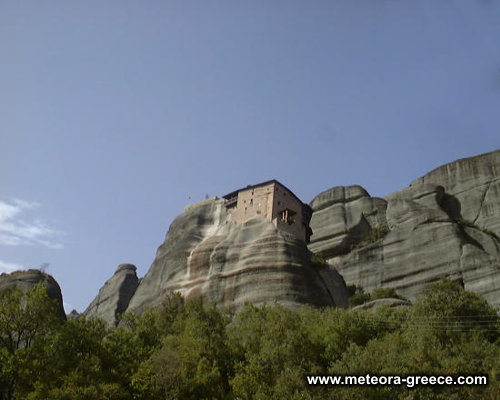The Holy Monastery of Saint Nicholas Anapausas is the first Monastery (at our left) that we meet as going up to the Holy Meteora. Its foundation goes back at the beginning till the middle of the 14th century.
The catholic was made under the Metropolitan of Larisa Saint Dionysus the Merciful and under the abbot of Stagi, Monk Nikanoras.

In 1527, the completion of the hagiography of the Catholic took place by Theophanis the Cretan, who is included in the most important hagiographers of Orthodoxy. At the frescos we can see the great perfection in the designing of the figures and the excellent chromatic reproduction.
Furthermore, in the Holy Monastery there is the chapel of Saint Antony, where remains of the frescos of 14th century exist. The few manuscripts of the Holy Monastery are kept in the sacristy of the Holy Convent of Saint Stephen
The rock, on the top of which the monastery is built, has a very limited surface. This fact affected the construction of the buildings of the monastery that could not extend. Therefore the only solution was to erect buildings in height. The monastery has three floors.
As to the construction date of the monastery there is neither enough evidence nor written sources. It is believed that the first hermits reached the rock during the early part of the 14th century. This dating is based on the remains of the frescoes (painted in the 14th century) of the St. Antony chapel that is situated on the first floor. The monastery was totally renovated in 1510 and the present katholikon -the St. Nicholas church- was built from the beginning by St. Dionysius, the Metropolitan of Larisa and priest-monk Nikanoras, the exarch of Stagoi. From the beginning of 1900 the monastery was abandoned and the desolation began. In the sixties the St. Nicholas monastery was restored and renovated by the Archeological Service of the region. Up to 1982 Father Palamas lived there. When he was forced to leave, the monastery was closed for 15 years. It was open by the priests of Kalampaka only in the summer for the tourists. It started to operate again in 1997.
The origin of the name is not ascertained. Anapausas may be the surname of a founder of the monastery, of priest-monk Nikanoras or of an earlier founder that lived in the 14th century. But there is also a second theory that prevails. According to this theory the name is owed to the location of the monastery because it offers physical and mental rest, refreshment and calm to everybody: to monks, visitors and humble pilgrims of the monastery.
Just like in the other monasteries, ascent to the St. Nicholas rock was made by ladders and the traditional net. The ascent took a long time because of the height of the rock. So, later they built steps carved in the rock. Today objects are hoisted electrically.
